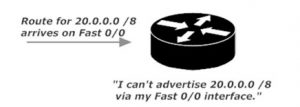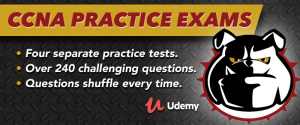CCNA And CCENT Daily Practice Exam: ADs And More!
In today’s daily CCNA and CCENT practice exam, we’re going to concentrate a bit on administrative distance (AD) with a little distance-vector routing thrown in for good measure.
Oh, yeah, one more thing — no multiple choice today! Every question in today’s practice exam is in flash card format. (And speaking of flash cards, be sure to visit in Sept. 2018 when my CCNA Flash Cards are ready to help you get certified.)
Right now, let’s get to today’s questions!
Question 1: What distance-vector protocol behavior is illustrated in the following exhibit?

Question 2: When it comes to administrative distance, is a lower AD most trustworthy than a higher AD, or is it the other way around?
Question 3: What is the AD of an OSPF route that was learned via route redistribution?
Question 4: There are three administrative distances associated with EIGRP. Name all three and the type of route each AD is assigned to.
Question 5: What is the AD of a route discovered by RIP version 2?
Before we get to the answers, I want to present you with one heck of a deal.
10 CCNA practice exams for $10!
Just purchase Chris Bryant’s CCNA Practice Exam pack on Udemy and then send your receipt to bogo@thebryantadvantage.com. I’ll then send you my CCNA Subnetting Practice Pack FREE via email that same day.
You can also buy the subnetting pack and we’ll send you the CCNA practice exams for free. Either way works. We’re not picky! Buy either one and get the other one free!
Let’s get to the answers!
Answer 1: The rule of split horizon states that a router can’t advertise a route via the interface upon which the route was learned in the first place. The router is learning about 20.0.0.0 /8 on Fast 0/0, so it can’t advertise that same route out that same interface.

Answer 2: When comparing administrative distances, the lowest AD is preferred.
Answer 3: With OSPF, the AD of a route learned via redistribution is the same as any other OSPF route — 110.
Answer 4: In contrast to OSPF, the EIGRP AD is affected when a route is learned via route redistribution. EIGRP considers that an external route and assigns it an AD of 170. Networks learned via normal EIGRP route exchange with neighbors are internal routes and are assigned an AD of 90. Finally, EIGRP summary routes are assigned an AD of 5.
Answer 5: The AD of a RIP route is 120, regardless of the RIP version that discovered it.
That’s it for today! Tackle these other CCNA and CCENT practice exams while you’re here, and I’ll see you tomorrow with another new exam.
Buy either one of these practice packs on Udemy, send your receipt to bogo@thebryantadvantage.com, and get the other FREE!
Chris B.






